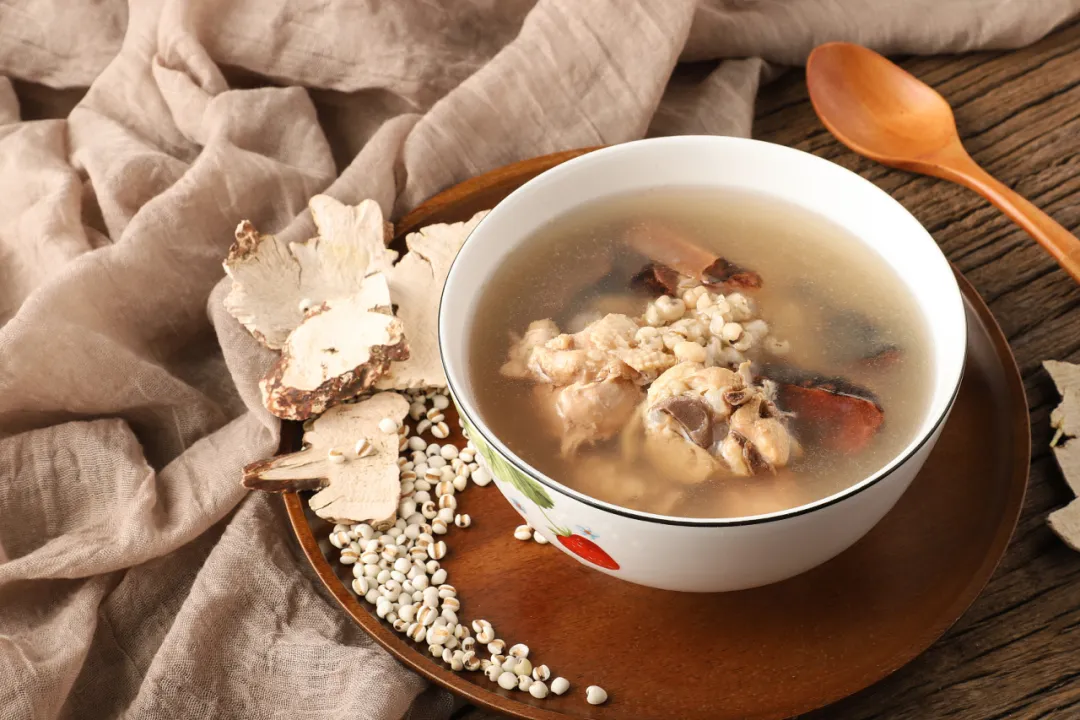Individuals with a Phlegm-Damp Constitution
Why Are They More Prone to “Lumps”?
Nodules, polyps, cysts… We often see these “lumps” mentioned in our health check reports. What exactly are they? Specialists might tell you:
Nodules are observed through imaging, and tissue hyperplasia or local inflammation can manifest as nodules in the body, such as thyroid nodules or lung nodules.
Polyps are generally growths that appear on mucosal surfaces, such as intestinal polyps or gallbladder polyps.
Cysts are sac-like lumps that can form on the surface of the body or within internal organs, such as liver cysts or ovarian cysts.

What you may not know is that from the perspective of Traditional Chinese Medicine (TCM) and its “holistic view”, the pathogenesis of these “lumps” has a high degree of similarity, and behind them, we can often find the shadow of Phlegm-Damp.
Experts explain: The “Phlegm” in Phlegm-Damp refers not only to the “tangible phlegm” seen in coughs and sputum but more often to “intangible phlegm”—Phlegm exists within any tissue, organ, or vessel in the body, and can circulate throughout the body with the flow of Qi and blood, leading to many diseases.
Where does Phlegm come from? When there is excessive dampness in the body that accumulates and does not transform, it easily forms Phlegm.
As for dampness, everyone is familiar with it; besides the “external dampness” from climate and environment, there is also “internal dampness”—caused by insufficient transformation and transportation by the spleen, leading to long-term accumulation of dampness in the body.
When Phlegm-Damp combines with cold stagnation, Qi stagnation, or blood stasis, and remains blocked in a certain part of the body for a long time, it will form “Phlegm masses”, which are commonly referred to as nodules, cysts, etc.
Spleen Deficiency
↓
Heavy Dampness, Dampness Transforms into Phlegm
↓
Phlegm-Damp Forms and Accumulates Long-term
↓
Formation of Phlegm Masses (Nodules, Fibroids, Cysts)
Therefore, regardless of whether you are currently troubled by these “lumps”, you can start with the fundamental approach of “tonifying the spleen, eliminating dampness, and transforming phlegm” for prevention and conditioning. It is essential to do this well.
Speaking of Phlegm-Damp constitution, we must also discuss what “constitution” means in TCM.
Constitution refers to the relatively stable inherent characteristics of the human body that manifest in functional and morphological aspects based on genetic and acquired factors.
According to the “Classification and Determination Standards of TCM Constitution”, human constitution can be divided into nine types: Yin Deficiency, Yang Deficiency, Qi Deficiency, Blood Stasis, Phlegm-Damp, Damp-Heat, Qi Stagnation, Special Constitution, and Balanced Constitution. Adjusting based on constitution can yield significant results.
It is important to note that constitution is not fixed; it can vary among different individuals and at different physiological stages.
Additionally, the same individual can have a mixed constitution; most people exhibit some degree of mixed constitution.
Simple Self-Assessment:
Do You Have “Phlegm-Damp” in Your Body?
Phlegm-Damp constitution is a state characterized by the accumulation of phlegm and dampness due to the dysfunction of fluid metabolism, primarily marked by a sticky and turbid quality.
How can you tell if you have “Phlegm-Damp”?
You might want to check if you have the following characteristics:
Body Type Characteristics: Obese body shape, soft and full abdomen.
Common Manifestations:
-
Excessive oiliness of facial skin
-
Easily flushed and red-faced due to rising temperatures
-
Large tongue with teeth marks, white greasy coating
-
Frequent sticky or sweet sensation in the mouth
-
Easily sweats, with sticky sweat
-
Chest tightness, excessive phlegm
-
Easily fatigued, feeling heavy and uncomfortable
-
Urine is scanty or slightly turbid
-
Loose stools or difficulty in cleaning after bowel movements
Tendency to Develop Diseases: Prone to metabolic syndrome, including abdominal obesity or overweight, abnormal lipid metabolism, hypertension, diabetes, insulin resistance, and/or abnormal glucose tolerance, thereby increasing the risk of cardiovascular diseases such as stroke and myocardial infarction.
If you meet multiple manifestations, you are likely to have a Phlegm-Damp constitution.
It is important to emphasize that the above self-assessment is for reference only; specific constitution types should be identified by a professional TCM practitioner for targeted conditioning. Different constitutions require different conditioning principles, and identifying the constitution for conditioning helps to promote benefits and avoid diseases.
Individuals with Phlegm-Damp Constitution
How to Regulate in Spring
Although Phlegm-Damp constitution may be inherited from parents, its formation is most closely related to lifestyle factors, such as unhealthy diet and lack of exercise.
In terms of dietary therapy, the first step is to eliminate dampness. Individuals with Phlegm-Damp constitution should consume less rich and greasy foods and more light foods that strengthen the spleen, eliminate dampness, and transform phlegm. Those with heavier phlegm-dampness can also eat more Yun Ling (Poria), Fu Ling (Poria), Bai Zhu (White Atractylodes), Lian Zi (Lotus Seed), Chi Xiao Dou (Adzuki Bean), Shan Yao (Chinese Yam), such as in dishes like Fu Ling Sha Ren Pig Stomach Soup or Yun Ling Bai Zhu Boiled Kudzu Soup.

Additionally, it is advisable to take advantage of the spring season’s rising Yang energy to clear out excess phlegm-dampness from the body, focusing on warming the spleen and kidneys. TCM believes that “the spleen is the source of phlegm” and “the kidneys govern water”; when the spleen is warmed by Yang, it can effectively transform and transport fluids; when the kidneys are warmed by Yang, fluids can evaporate and distribute, preventing internal stagnation. By cutting off the source of “internal water stagnation”, the formation of “phlegm” is also hindered.
Among the recommended ingredients, Chen Pi (Dried Tangerine Peel) is highly recommended for its ability to regulate Qi, strengthen the spleen, and dry dampness to transform phlegm. For daily health maintenance, you can soak 3 grams of Chen Pi in water, brew it with Pu-erh tea, or cook it in porridge to help transform cold phlegm and expel dampness in spring.
Dietary Therapy: Try Three Teas + Two Soups
Chen Pi Rose Flower Pu-erh Tea
Ingredients: 10 grams of Guang Chen Pi, 10 grams of Rose Flower, appropriate amount of raw Pu-erh.
Method: Wash 10 grams of Guang Chen Pi, tear it into small pieces, place it in a tea cup; wash 10 grams of Rose Flower, add it to the raw Pu-erh, pour boiling water over it, cover the cup, and steep for about 5-10 minutes, then strain and drink.
Comment: Strengthens the spleen, transforms phlegm, aids digestion, and relieves depression. Suitable for those with gastrointestinal stagnation, obesity, and phlegm-damp or liver Qi stagnation constitution.
Chen Pi Fu Ling Tea
Ingredients: 6 grams of Chen Pi, 10 grams of Fu Ling, 10 grams of Dang Shen (Codonopsis), 3 grams of Chuan Bei Mu (Fritillaria).
Method: Grind Chuan Bei into powder, add the above ingredients with an appropriate amount of water, and boil for 20-30 minutes, then drink as tea.
Comment: Strengthens the spleen, eliminates dampness, transforms phlegm. Suitable for those with spleen deficiency and heavy phlegm-dampness.
Lotus Leaf Hawthorn Chen Pi Damp-Expelling Tea
Ingredients: 12 grams of dried lotus leaf, 15 grams of hawthorn, 15 grams of Chen Pi, 10 grams of Bei Qi (Astragalus), 5 grams of Goji Berries.
Method: Tear dried lotus leaves into pieces, slice Chen Pi, slice Bei Qi, mix and grind into powder. Divide the mixed powder into tea bags. Each time, take one bag, brew with boiling water, steep for 15 minutes, and drink. Consume twice daily.
Comment: Reduces fat and weight, regulates Qi, invigorates the mind, transforms phlegm and stasis, suitable for phlegm-damp obesity, dizziness, and drowsiness.
Yun Ling Dang Shen Fan Bone Soup
Ingredients: 30 grams of Yun Ling, 20 grams each of Dang Shen and Bian Dou (Hyacinth Bean), 6 grams of Dang Gui (Angelica), 600 grams of Fan Bone, 3 slices of ginger.
Method: Wash and soak all herbs; wash and cut the fan bone into sections. Place all ingredients with ginger into a stewing pot, add 1.5 liters of cold water, cover, and steam for 2-3 hours, then season to taste.
Comment: Strengthens the spleen, expels dampness, nourishes Yin, and generates marrow. Especially suitable for those with phlegm-damp, Yin deficiency, or Qi deficiency.
Qian Shi (Euryale) and Yi Yi Ren (Job’s Tears) Stewed Chicken Feet
Ingredients: 30 grams of Qian Shi, 20 grams of Yi Yi Ren, 500 grams of chicken feet, 150 grams of lean meat, 3 slices of ginger.
Method: Wash and soak Qian Shi and Yi Yi Ren; wash chicken feet and lean meat. Then place everything into a large stewing pot, add 1.5 liters of cold water, and steam for 2-3 hours, then season to taste.
Comment: Tonifies the spleen, expels dampness, strengthens muscles and bones. Especially suitable for those with phlegm-damp or Qi deficiency.
Additionally, avoid living in damp and cold environments for extended periods; it is recommended to engage in walking, jogging, ball games, swimming, Ba Duan Jin (Eight Pieces of Brocade), Wu Qin Xi (Five Animal Frolics), and various dances, following the principle of moderation.
It is also advisable to consider meridian health practices under the guidance of a TCM practitioner, such as Gua Sha (scraping therapy) and acupoint massage at Yang Ling Quan, Feng Long, Zu San Li, etc.
Source: Health Appointment

【Disclaimer: We respect originality, and our main purpose is to share information. Copyright belongs to the original author. If your rights are infringed, please inform us in a timely manner, and we will delete it within 24 hours.】
Editor: Zhu Lina Editor-in-Chief: Li Na
 :(Submission)[email protected]
:(Submission)[email protected]
 :(0971)12320
:(0971)12320
For more exciting content, please follow:
 :健康青海12320
:健康青海12320
 :2202438257
:2202438257
 :健康青海12320
:健康青海12320
 :http://www.jkqh12320.com
:http://www.jkqh12320.com

Discover More Exciting Content
Follow Our Official Account


